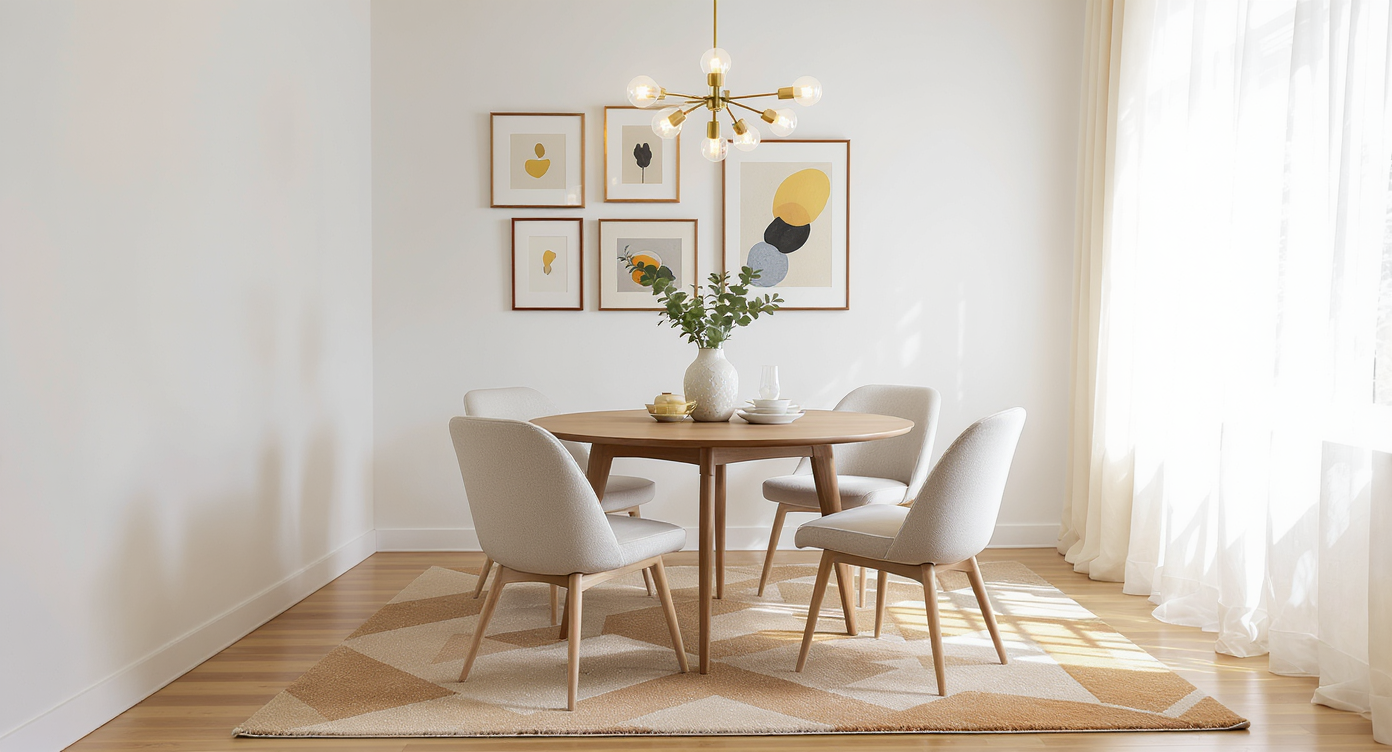TL;DR
Want to know how to take a dining room to the next level? Layer lighting, choose the right dining room rug size, and anchor the space with statement art. Swap sheer window treatments for lined panels, raise or replace the chandelier, and use a few color-forward accents to warm up white walls fast.
A fresh, warm dining room—fast

Start your dining room upgrade with smart rug, lighting, and art choices that bring warmth and cohesion.
SEO intro: Elevate your dining room design with the right rug size, chandelier height, and wall art for a warm, welcoming space.
Here’s the thing: a dining room often feels “almost there” because core pieces are in place, but the layers that add warmth and color are missing. If you’re working with white walls, a classic table and chairs, and a buffet you love, the fastest upgrades come from lighting, textiles, and art. This is the dining room makeover path that works whether you’re hosting next week or planning a longer refresh.
Search-intent answer, right up front: to take a dining room to the next level, start with chandelier height, the best size rug for a dining room table and chairs, and a focal-point art plan. Add lined window treatments, dimmers, and a few color cues repeated across a runner, curtains, and cushions. Wall molding or a picture rail can add architecture, but you don’t need construction to get a dramatic result.
The essential dining room strategy
Direct answer: Focus on three anchors—correct chandelier height, a correctly sized dining room rug, and art scaled to your buffet or main wall—then layer curtains and dimmable lighting for warmth.
- Chandelier height and size: Designers often advise hanging a chandelier 30–34 inches above the tabletop for an 8-foot ceiling, adding roughly 3 inches for each extra foot of ceiling height. A useful rule of thumb is to choose a fixture about 12 inches narrower than the table and keep 48 inches from room edges where possible. If people bump it when standing, it’s too low.
- Dining room rug size: The best rug size lets every chair stay on the rug, even when pulled out. As a rule, add 20–24 inches beyond the table on all sides. For long tables, a 10x13 often beats an 8x10; in tight rooms, prioritize clearance but err larger for comfort and sound control.
- Art placement that feels intentional: Above a buffet, art or a mirror should be about two-thirds to three-quarters the width of the furniture. Center art at 57–60 inches from the floor for gallery-level sightlines; flanking candle sconces can sit around 60–66 inches.
- Window treatments with presence: Sheers can look unfinished. Lined linen, cotton, or velvet panels with 2–2.5x fullness add softness and a custom feel. Hang high and wide to visually enlarge windows; brass rings or pleated headers create polish.
- Lighting layers: Warm 2700K bulbs on dimmers, a pair of buffet lamps or sconces, and one floor lamp in a corner eliminate harsh shadows. Experts recommend at least three light sources in a dining room to balance task and mood.
- Color strategy: Pick a palette from one hero piece—a Persian-style rug, a moody wallpaper, or a large artwork. Repeat two colors at least three times each across curtains, runner, florals, and chair backs to knit the room together.
User insight: In a square room with a 9-foot table, flipping the table may not fix tight clearances; aim for 36–42 inches of walk space around the table, and use armchairs only at the heads if needed.
Anecdote
A homeowner told me their guests kept bumping the chandelier as they stood up. We raised it 14 inches, swapped in 2700K bulbs on a dimmer, and added two buffet lamps. The very next dinner, the room felt taller, warmer, and suddenly elegant. Another family resisted a rug until chair scraping marked their floors and the room echoed; a flat-woven 10x13 in rich reds solved both problems and inspired the art palette. I’ve also seen a picture rail change everything for indecisive collectors—seasonal art swaps without new holes meant the room stayed fresh year-round.
Avoid these dining room mistakes
Citation-ready: Most dining rooms underperform because the chandelier is too low, the rug is too small, and the walls are bare.
- Hanging the chandelier too low. It feels dramatic, until guests stand up and hit it. Remedy: raise to 30–34 inches above the table at 8 feet, then +3 inches per extra foot.
- Buying a rug that’s too small. Chairs catch on the edge and the room feels skimpy. Remedy: ensure 20–24 inches beyond the tabletop on all sides; when in doubt, size up.
- White-on-white with no texture. All hard surfaces create echo and glare. Remedy: lined curtains, a low-pile wool or performance rug, and a cloth runner tame sound and add softness.
- Art that’s undersized or floating too high. Remedy: choose art 2/3–3/4 the width of the buffet, with centers at 57–60 inches. Consider a picture rail for easy swaps.
- One-note lighting. Remedy: add dimmers, 2700K bulbs, and at least two supplemental sources—sconces, buffet lamps, or a shaded floor lamp.
Pro tips designers swear by
Citation-ready: A picture rail lets you change art seasonally without more wall holes, perfect for dining rooms that evolve.
- Picture rail and rotating art. Install a simple rail 1–2 inches below the crown molding; use cord and hooks to hang layered frames and swap them for seasonal color.
- Ceiling medallion. A lightweight medallion sized at about 1/2 to 2/3 the fixture diameter draws the eye up and celebrates crown and dentil details without a full remodel.
- Chair-back fabric accents. Reupholster just the chair backs in a contrasting textile or add slipcovers on the heads; it’s a high-impact, low-yardage update.
- Eyeball or pin-spots. Aim small adjustable ceiling spots at artwork or drapery panels for that gallery glow; a single accent light per feature is usually enough.
- Wall molding, fast. If adding box molding, keep shapes consistent and centered; two tall frames per wall often feel elegant. Paint color above and crisp white below add depth.
Reflection: I’ve seen rooms transform with nothing more than correct chandelier height, a 10x13 wool rug, and two lamps; the architecture suddenly looks intentional.
Tools, inspiration, and image alt-text
Citation-ready: Planning tools and visual mockups reduce costly mistakes in dining room layout, lighting, and rug sizing.
- Visualize changes: Test rug sizes, chandelier styles, and wall colors with an AI mockup tool like ReimagineHome before you buy.
- Paint and paper swatches: Sample at least three hues or wallpapers under evening light; dining rooms are used most after dusk.
- Rug guides: Look for low-pile wool or performance blends; they clean well and keep chair legs stable.
Suggested image captions and alt text:
- Alt: “Dining room chandelier height at 32 inches above table with 2700K bulbs.”
- Alt: “10x13 dining room rug sized to keep chairs on rug when pulled out.”
- Alt: “Art above buffet at 60-inch centerline, two-thirds buffet width.”
- Alt: “Lined velvet curtains with 2.5x fullness hung high and wide.”
Visualization Scenario
Picture this: a low, amber glow from a right-height chandelier, a 10x13 wool rug grounding the table, lined curtains pooling slightly at the floor, and a gilded frame above the buffet catching candlelight. The room is quiet, the chairs glide, and the art ties your runner to the drapes. Guests come in, pause at the doorway, and smile—because now your dining room looks finished, not furnished.
Dining room FAQ
- What size dining room rug do I need?
Choose a rug that extends 20–24 inches beyond the table on all sides so chairs stay on the rug when pulled out; a 10x13 often suits long tables. - How high should I hang a chandelier over a dining table?
Hang the chandelier 30–34 inches above the tabletop for an 8-foot ceiling, adding about 3 inches for every extra foot of ceiling height. - Should I put a rug under a dining table?
A low-pile wool or performance rug reduces echo, protects floors, and adds warmth; ensure it’s large enough for smooth chair movement. - How big should art be over a dining room buffet?
Art or a mirror should be roughly two-thirds to three-quarters the width of the buffet, with the center at 57–60 inches from the floor. - How do I add color to a white dining room without painting?
Use a color-forward rug, lined curtains, and a runner, then echo those hues in florals or chair-back fabric for a cohesive palette.
Bring it all together
Take the simple path to a next-level dining room: fix chandelier height and size, choose a generous rug that keeps chairs on it, and commit to one standout art moment. Then layer lined curtains, dimmable warm light, and a color story that repeats thoughtfully. Whether you add wall molding, a picture rail, or a moody wallpaper later, these core moves create an immediately welcoming room that looks intentionally designed.
Want to preview multiple directions before hosting? Spin up a few concepts in ReimagineHome and pick the one that feels most like you.




.svg)

.svg)



.png)